From Waste, The Scream Therapy, Betty Ford Clinic, Ford’s Imaginary Inferno to Ford’s Fuzz Inferno | Interview | Hans Von Seydlitz
Hans Von Seydlitz has been part of the Dutch alternative scene for decades. Originally started in hardcore punk group Waste, continued in bands like The Scream Therapy and Betty Ford Clinic, to his solo project Ford’s Imaginary Inferno and the latest Ford’s Fuzz Inferno.
Earlier this year he self-released a spectacular 5-track EP archive recording of his band Waste. This 7-inch includes an unusual version of the title track from the band’s sought after 1982 ‘History Repeats’ EP, plus some ultra-blistering ragers from the same era, showcasing the guys at their fastest and most furious.
His latest project Ford’s Fuzz Inferno revisits his hardcore punk roots. He is joined by his friend Patrick Delabie (Scoundrels, Betty Ford Clinic and owner of the renowned Studio 195) on drums. The duo’s super explosive debut-EP offers five short, ultra catchy blasts that bridge the gap between fuzzed-out garage-punk and early hardcore. And as a bonus there’s an almost 3-minute freak-noise jam!
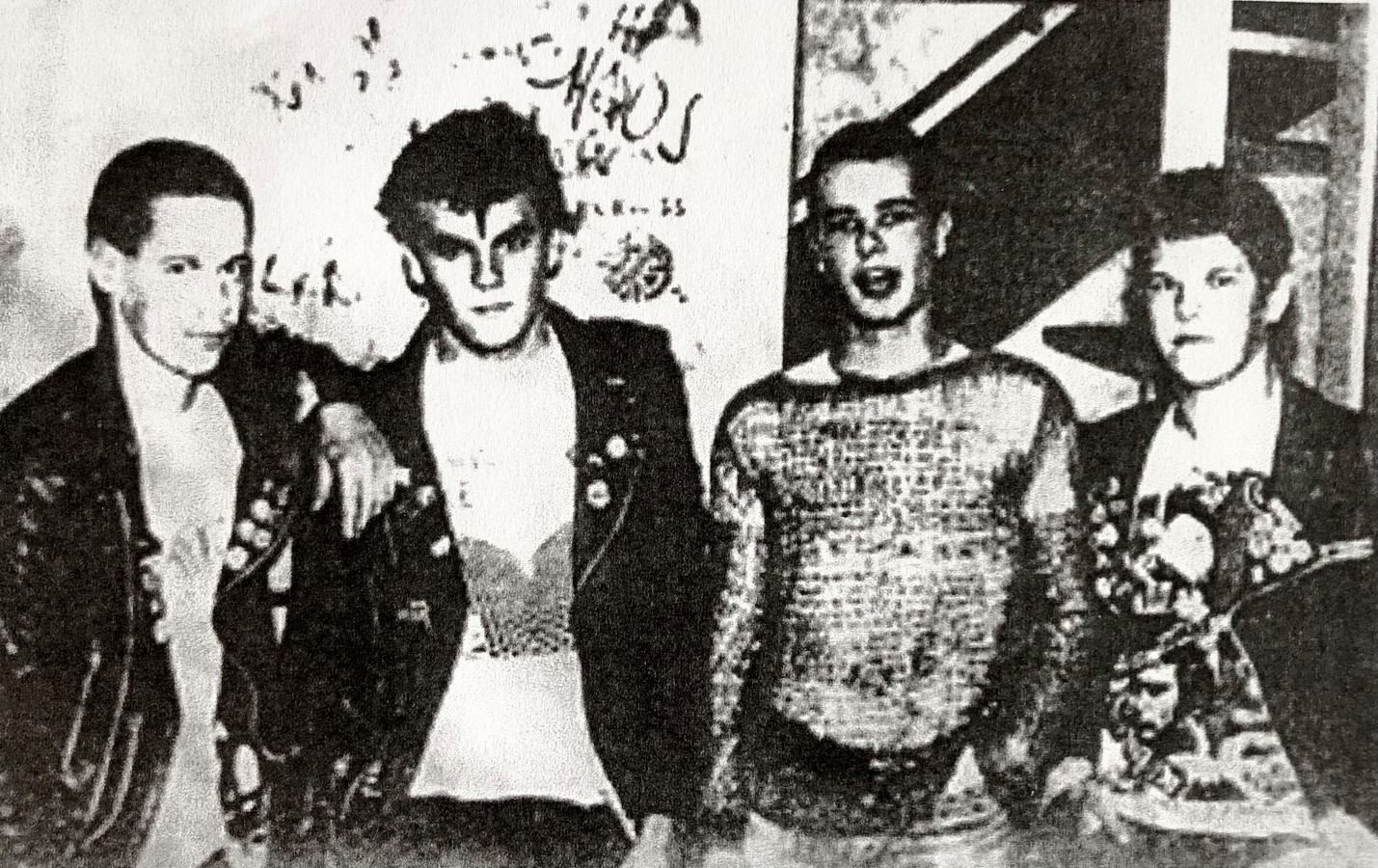
“Thou shalt never underestimate the power of fuzz”
How did you get first interested in music? What kind of music did you listen to as a young teenager and where did you grow up?
Hans Von Seydlitz: First I’ll answer the last part of the question. My childhood had a kind of unusual start. In 1966, when I was three years old, my father got stationed in Belgrade as a military attaché. Yes, between the summers of 1966 and 1969 I literally had the honour of being president Tito’s neighbour. And vice versa, of course. From that period I remember a song called ‘Jedan Dan’. It was a number one hit in Yugoslavia and I loved it. After we (that’s my parents, my older brother and me) returned to The Netherlands I started following the national charts pretty much straight away. I liked all kinds of stuff, no genre specifically. I wasn’t even aware of any genres yet. There were just songs which I either liked or not. When it comes to my love for music, this definitely was the most open minded and unbiased period of my life.
In 1972 the glam rock-era started. I still love ‘Crazy Horses’ by The Osmonds, Alice Cooper’s ‘Elected’ and David Bowie’s ‘Jean Genie’. It was then that I began to develop a preference for energetic pop and rock songs with loud electric guitars. Of course Slade, The Sweet and Gary Glitter also became faves. The Sparks’ album ‘Kimono My House’ (from ’74) is still in my personal list of all-time favourite lp’s. There are very few albums on which I really love each and every track. ‘Kimono My House’ is one of those records.
After the glam-era I experienced something like a black hole for about two years. But then punk kicked in. In 1977 The Stranglers appeared on Dutch television for the first time. I couldn’t believe what I heard and saw. I was in shock. ‘Something Better Change’ really was a life changer.
Was there any underground scene you were part of as a teenager?
During the punk-era I was living nearby (and, a bit later, in) Breda, a city in the south-west of The Netherlands. Most of the punk gigs there – as well as other “alternative” events – took place at a small, but enjoyable venue called KWJ. In 1981 or ’82 the name changed into Para. That place was sort of a second home for the local punk/underground crowd. All the regular visitors knew each other well and it could definitely be called “a scene”. Throughout the ‘80s I spent as much time there as possible.
When you were 18 years old (1981-1983) you played guitar in a hardcore punk band called Waste. Was this your first band? How did Waste start?
Before I joined Waste I was in a band called Abzurd Act. I started that band in 1979 with a couple of guys from school. I was 16 and had just bought my first electric guitar. We were beginners and that’s how we sounded. Nevertheless, we managed to put together a live set, which already was quite an accomplishment in itself. We did a couple of gigs in the Breda area and had fun. However, half of the band (including myself) wanted to play punk rock, the other half preferred a less extreme, more new wave oriented direction. The result was neither one nor the other. For me – and my identity! – this was a bit of a problem. An even bigger problem was that the other members wouldn’t let me use my fuzz pedal. They said it made my guitar sound like a coffee grinder. I thought that was a good thing, they thought differently.
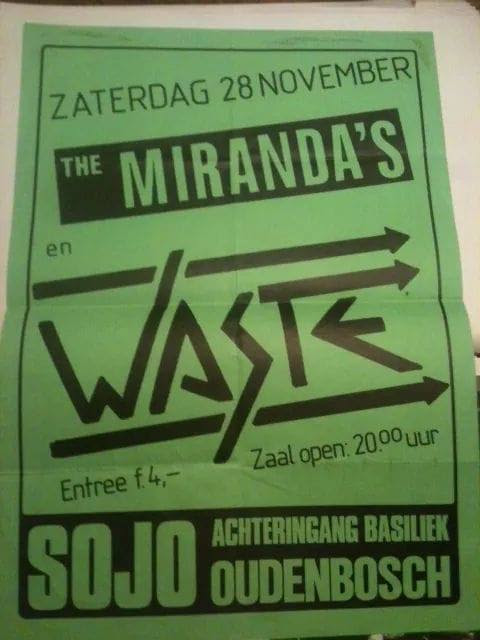
During those days I paid no attention whatsoever to my homework and I skipped class as often as possible. My parents had some serious worries about my future and, as a last resort, sent me to a kind of boarding school in Oudenbosch, a town not very far from Breda. This was in the summer of 1980. To my surprise Oudenbosch had a small, but fanatical punk scene. I soon became friends with three guys who had plans to start a punk band. Richard Schouw had the right attitude for a singer, René Peperkamp played bass (and was pretty impressive already) and Wilco Wessels, well, he had a guitar, but couldn’t actually play it. There was no drummer in sight and circumstances were far from promising, but the guys seemed dead serious. That was good enough for me and in the summer of 1981 I decided to leave Abzurd Act and join my new friends. In the meantime I had developed my own style of playing punk guitar. It was rather radical and chaotic, but with my fuzz pedal it sounded pretty cool. The guys gave me the thumb up and I was in the band. My adventures with Waste had started. Wilco soon decided he shouldn’t stand in the way of developments and left. I wrote a shitload of songs (some with lyrics by Richard) and we rehearsed those every Sunday evening in a local monastery, where we could practice for free. Two or three months after we’d started we suddenly had a drummer. A Sex Pistols-fan called John Konings showed up, pretty much out of the blue. John’s drumming was unbelievable. From the moment he joined us we sounded like a real band. Not much later we played our first gig, at a party in a local factory hall. We surprised everyone, including ourselves.
“UK punk bands as a whole left me no other choice than to dedicate my life to music”
What can you tell us about your 1982 release ‘History Repeats’ which was issued on Miranda Records?
Miranda Records was a small independent label run by Dick Pinkster and Rob Musters, two members of The Miranda’s. In the late ‘70s The Miranda’s were the only serious punk band in Breda. Those guys were a few years older than me and I really looked up to them. They were the first punk band I ever saw live and they were absolutely spectacular. They released their first EP in early ’81. As far as I was concerned that 7” put them in the same league as all my favourite English punk bands.
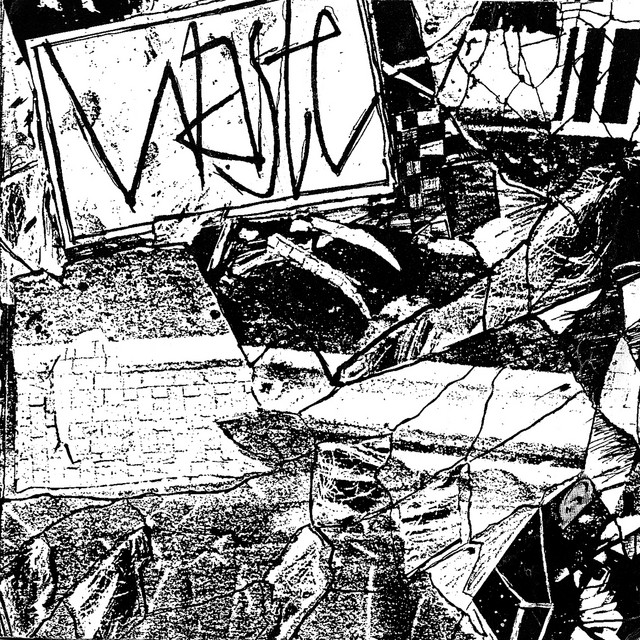
After we had played our first gig in the factory word got around quickly. The Miranda’s also heard about us. We sent them a tape with rehearsal recordings and they invited us to support them on a couple of occasions. Our gigs went down well and The Miranda’s liked what we were doing. In the summer of 1982 Rob and Dick suddenly asked us if we were interested in putting out an EP on their label. We didn’t need much time to come up with an answer. That summer we recorded a bunch of songs in a village called Standdaarbuiten. I thought those tracks sounded fine, but Rob and Dick decided we should choose some songs from that session and re-record them in a different studio. The resulting four tracks (recorded by sound engineer Bart van Poppel and Miranda’s-guitarist Frank Mathijssen) became our ‘History Repeats’ EP. It was pressed in an edition of 500 copies and released in December 1982. It sold out rapidly.
Earlier this year you released ‘The Lost Tapes – Oudenbosch HC 1981-1983 – Vol. 1’. It’s a pure adrenaline 5-track EP consisting of rehearsal room recordings from the band. Did you come across these recordings unexpectedly or was there a long time plan to release it? On that note, what can you say about the songs that appeared on this EP?
A while ago Richard visited me (we live in different parts of the country) and of course we talked about the old days. Both of us had noticed quite some people still remember Waste. Our ‘History Repeats’ EP has become something of a collectors item and every now and then someone asks us if there are plans to reissue it. I thought it would be much more interesting to release some archival material. I had in mind to select some songs from the ‘Standdaarbuiten demo’, but no decent copies seemed to exist anymore. So instead I checked out some live recordings. Quite a lot of Waste live stuff floats around on the internet, but most of it is extremely messy and of very poor sound quality. However, I was pleasantly surprised when I dug up a tape with rehearsal room recordings, made 40 years ago. Five cuts in particular are much worth while. Those are the songs I used for the ‘Lost Tapes’ EP. The sound is very raw and primitive, but also very lively. Even the balance between the individual instruments and vocals is excellent. Some people actually thought the tracks were mixed in a studio.
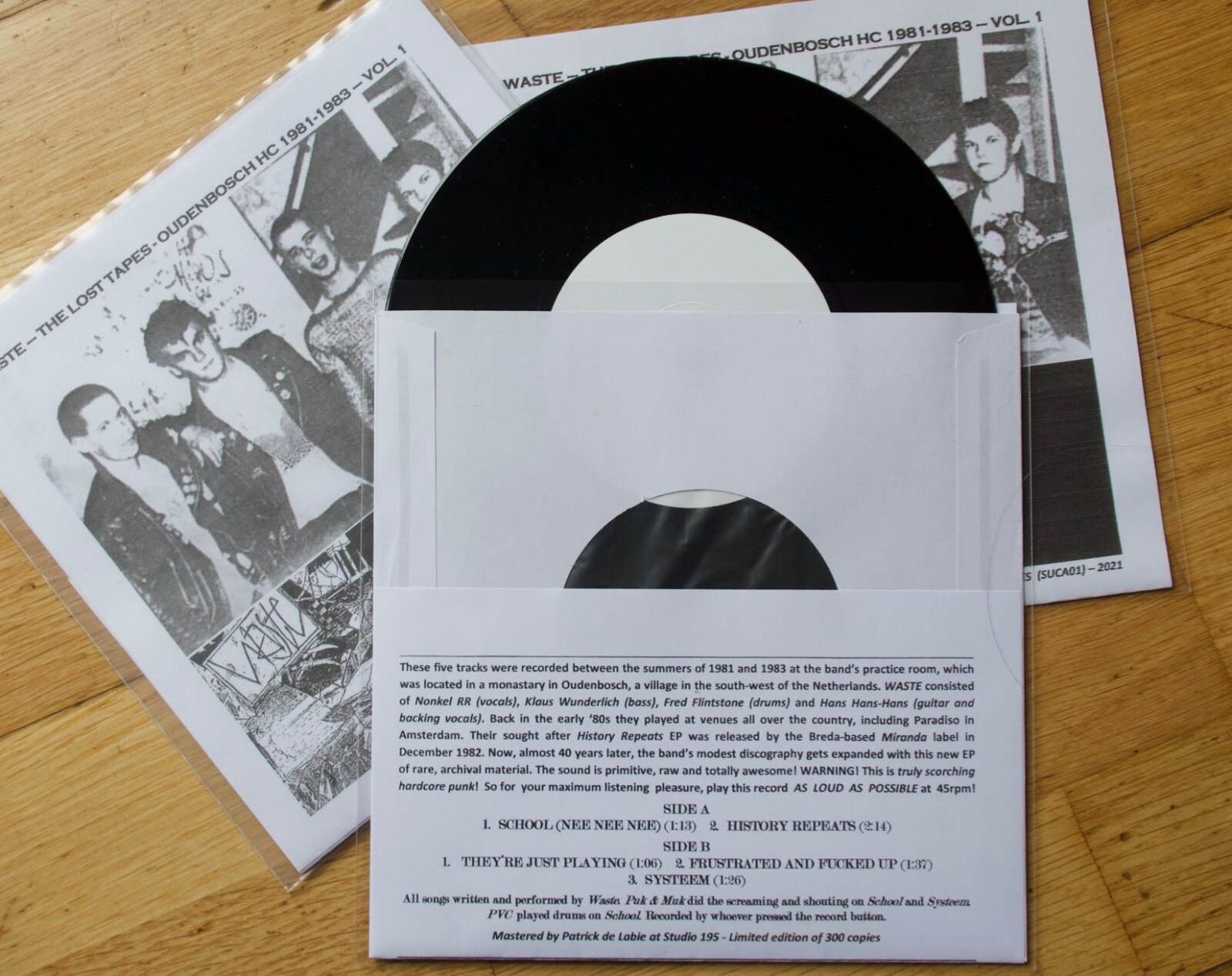
So the ‘Lost Tapes’ EP comprises five songs. One of them is an unusual version of the title track from our ‘History Repeats’ EP, done with a different structure. Then there are two real hardcore scorchers, ‘They’re Just Playing’ and ‘Frustrated And Fucked Up’, with Richard at his furious best. The remaining two tracks feature Puk & Muk on vocals. Puk & Muk (a.k.a. Petra and Kim) were two girls we knew from the local punk scene. I guess they were like 15, maybe 16 years old at the time. If I remember correctly they told us they were a vocal duo without a band. We thought it could be fun to invite them over to our practice room and find out if they were any good. So I wrote two or three songs with Dutch lyrics for them (one had lyrics by Richard) and they screamed their lungs out, most notably on a song about hating school. When it comes to raging teenage femme punk hysteria, trust me, this recording (with John’s best friend Peter a.k.a. PVC on drums) is the real deal! Puk & Muk also joined us on stage a couple of times. That was fun too. Unfortunately we have no clue about the girls’ (or, by now, ladies’) whereabouts today, so they still didn’t get their copies of the EP. They probably don’t even know it exists. Hopefully they’ll show up one day.
Did you do a lot of gigs with Waste? What are some venues you played and what are some bands that shared stages?
Waste was active as a live band for only a year and a half. During that time we played enough shows to keep ourselves busy. We did three or four gigs in Breda and there were a couple more in the region: two in Roosendaal, two in Oudenbosch and I recall a small festival in Terheijden, the village where I spent most of my childhood. We also played in other parts of the country. In Amsterdam we had gigs in the punk venues Oktopus and PH31, and in January 1983 we supported Anti-Pasti at Paradiso.
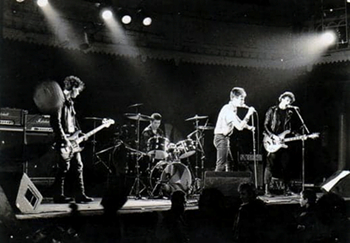
We also played Parkhof in Alkmaar, which was another legendary Dutch punk club, and the Stokvishal in Arnhem. On that occasion we were part of a festival, the other bands being The Anti-Nowhere League and the Dutch groups Zmiv, De Boegies and The Scoundrels. The latter were from Zundert, where Vincent van Gogh was born. This was the band Patrick Delabie (my current duo-partner in Ford’s Fuzz Inferno) was in. We got along really well and played a couple more times together, a.o. in Turnhout, Belgium. Other bands we shared bills with (that I didn’t mention already) included Venco from Roosendaal (John’s other band) and Squelettes (featuring punk poet Diana Ozon) from Amsterdam.
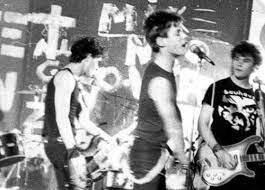
What’s the story behind The Scream Therapy?
When we started with Waste the atmosphere within the punk scene was excellent. People were friendly and peaceful, and I only experienced positive energy. Unfortunately this was about to change soon. Newcomers totally misunderstood the raw aggression of the music and the atmosphere at gigs often became grim and violent. We weren’t into that at all. In those days Richard, René and myself also listened to bands s.a. Bauhaus, Virgin Prunes and (Southern) Death Cult, so we decided to start a new, post-punk/goth rock type band. In the early summer of 1983 we played our final Waste gig in Amsterdam and a couple of days later we started rehearsals as The Scream Therapy. John wasn’t into it and left. His friend Pierre Castelijn (also in Venco) became our drummer.
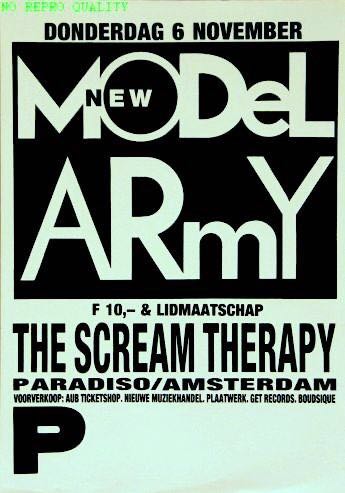
The Scream Therapy issued a tape-only release in 1984, followed by the album ‘Capital Of Hate’ and two single releases; ‘Legal Business’ and ‘Silver Mountain’s Majesty’. The sound changed quite drastically from your early Waste years, but the DIY spirit remained.
I know that the 1984 tape is on Discogs, but it never was an official release. It was a demo we used for booking gigs. After playing straight forward punk it wasn’t easy to adopt a totally different style. That 1984 cassette proved we still had a lot of work to do. If the demo is of any interest at all, it’s because back then we were one of the very few Dutch bands playing “death rock” (as it’s called today, not back then). But as said, the music itself isn’t very convincing. Nevertheless, in those days we could open for The Cult, Play Dead, Christian Death, Killing Joke and many more, simply because hardly any other Dutch bands fitted the bill.
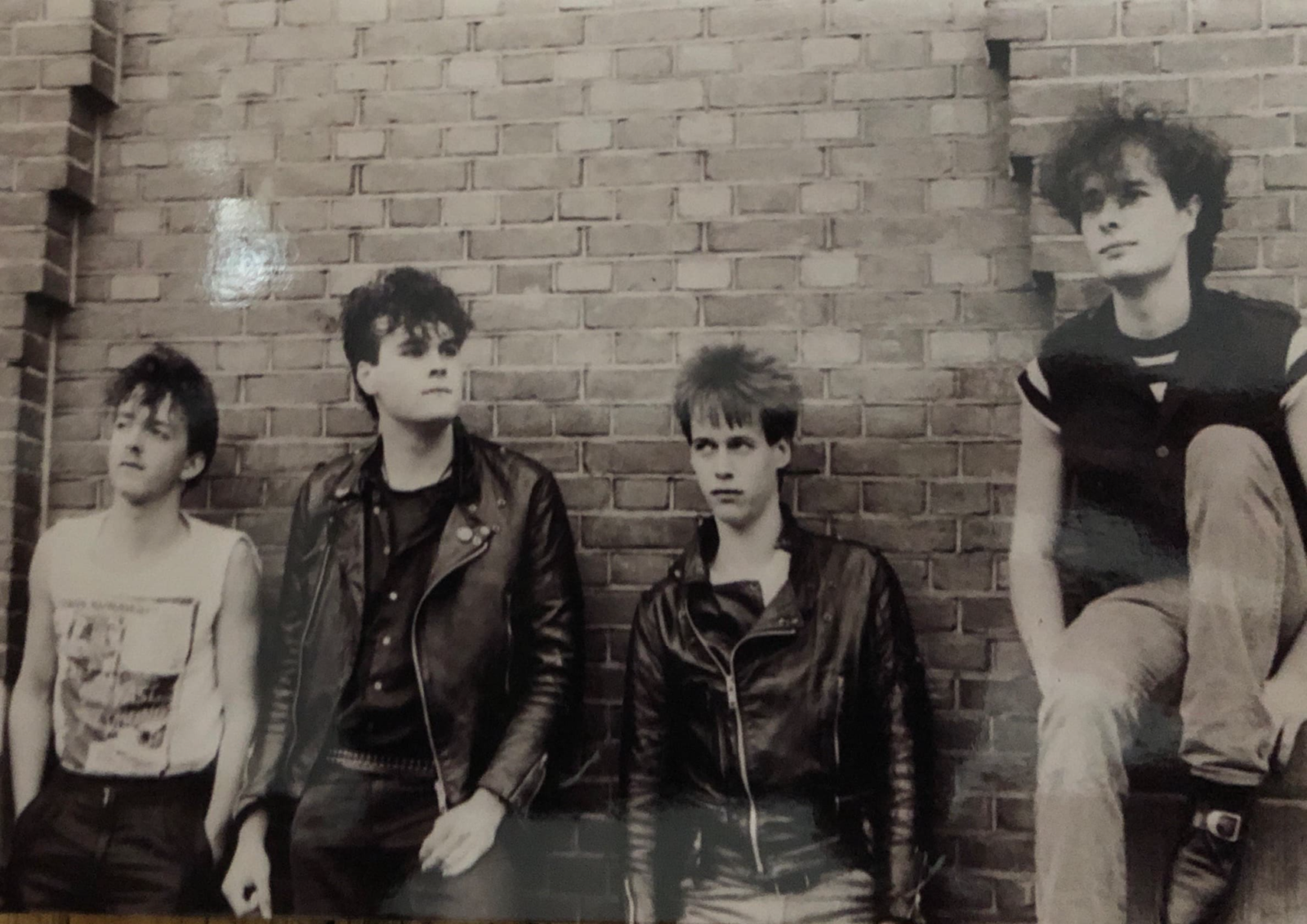
Shortly after we recorded our first demo Richard left due to personal circumstances. I took over vocal duties and we carried on as a three-piece for a while. In 1985 we added a second guitarist to the line-up. This was Mark Hensley, an American guy living in Breda. Mark’s presence was an improvement, but he soon returned to the USA and we were back to being a trio. (By the way, Mark would later become a successful sound engineer. He recorded the 4 Non Blondes’ hit ‘What’s Up’ and recently he even won an Emmy award for his contributions to the tv series ‘Genious Picasso’. Mark definitely did something right!)
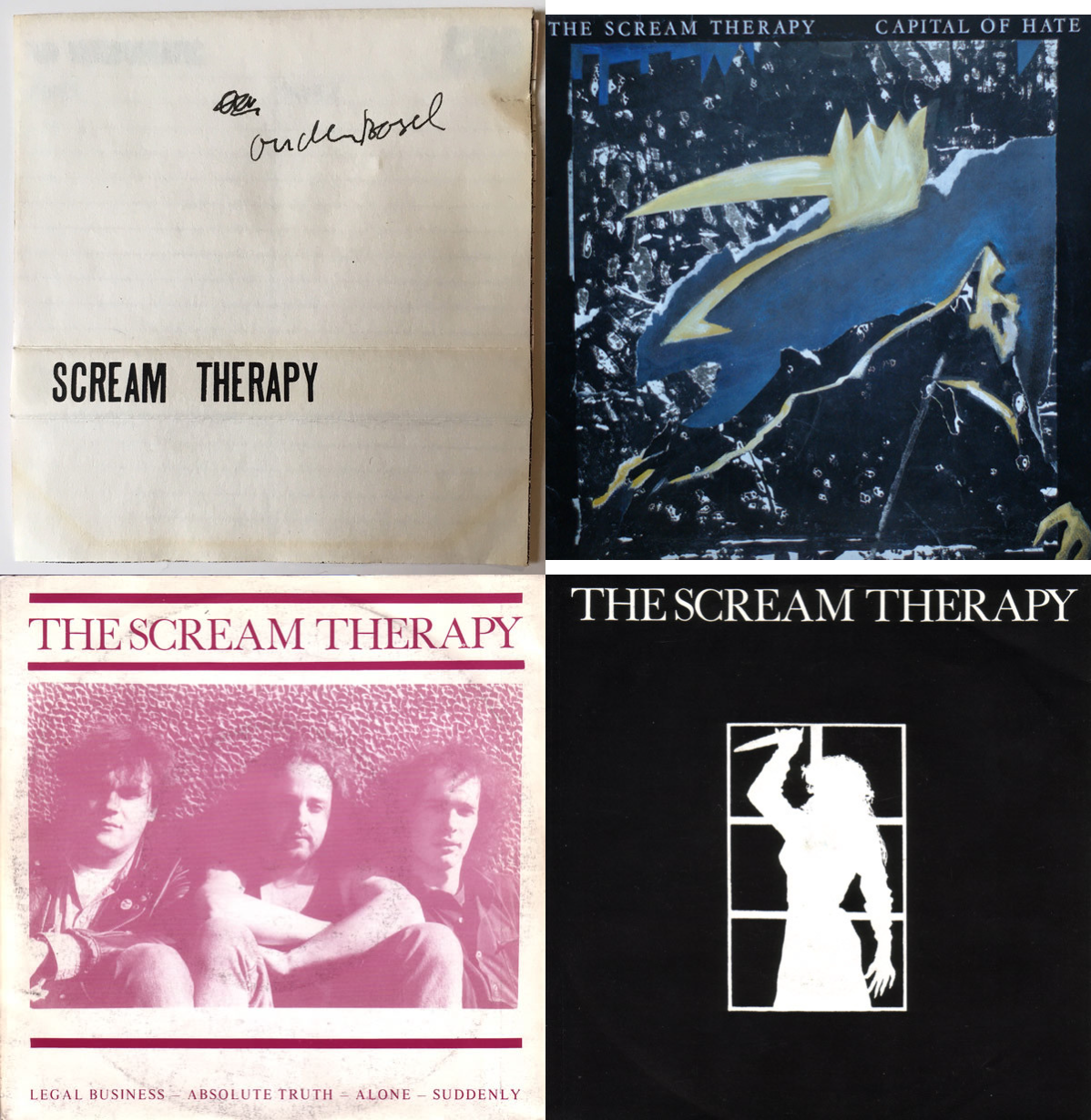
The first Scream Therapy single, ‘Silver Mountain’s Majesty’, was self-released in 1986. It contains two songs sounding like, let’s say, a mixture of Death Cult and Sisters Of Mercy. In retrospect I feel we should have waited a bit longer before putting out our debut, but well, we had our egos and were rather ambitious. The next year, when we released our six-track mini-LP ‘Capital Of Hate’ (recorded by Hungarian-Dutch studio engineer Lats Varga), the dark influences were gone. The style had become something like punk’ish underground rock with a clear New Model Army-influence in the bass department. This release was much better than our first single. In 1988 we put out an even more punk-influenced four-track EP, ‘Legal Business’. The following year I decided to call it quits. To begin with because I really felt we had been copying other bands a bit too much and we had changed our style too often. And secondly because I was seriously getting into ‘60s music. I wanted to use those influences and The Scream Therapy just didn’t seem to be the right band for what I had in mind. It was no easy decision. René and Pierre weren’t only my long-time bandmates, they also were my best friends.
I only recently discovered Betty Ford Clinic, another band you were part of. What’s the story behind the group and ‘Tralalapompompom’?
In the Summer of 1990 I ran into Patrick Delabie at a Gun Club show. We decided to start a new band together, rooted in punk, but incorporating as many other styles as possible. My ex-Scream Therapy bandmates Pierre and René completed the line-up and Betty Ford Clinic was born. About a year and a half later we started performing live. We took great pleasure in confusing and even alienating our audience. Not only musically by adding elements of a.o. surf, psychedelic rock, jazz, trucker’s music, experimental noise and even Broadway musicals to our punk sound, but also by dressing totally uncool. On stage we often looked like a bunch of complete idiots. People weren’t always amused. Nevertheless, it didn’t take long before we signed a deal for three 7”es with Boom! Records from Belgium. I think our first single, ‘Easy Judy’ (1992), was a good example of our eclectic approach. It had a bouncy Britpop beat in the verse, a punk’ish chorus (with stuttering vocals à la Bachman Turner Overdrive), and twin guitar work in the vein of Thin Lizzy in the instrumental break. And yet it all made perfect sense.
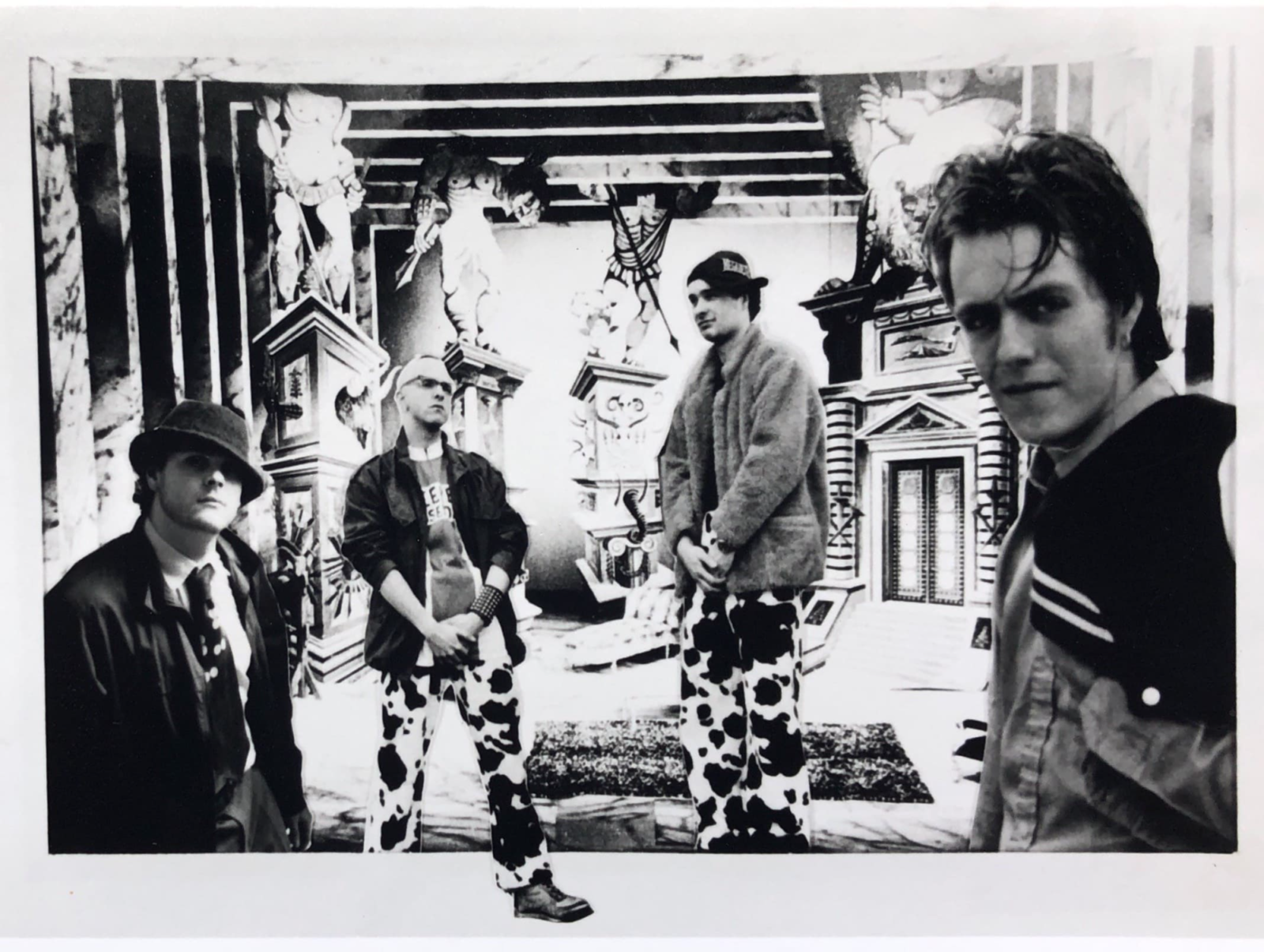
Shortly after the release of our debut-single Dutch label GAP showed serious interest. Following negotiations between GAP and Boom! we switched labels. With GAP we were allowed complete artistic freedom. (Boom! was very much focused on radio airplay.) We recorded our 1993 CD ‘Tralalapompompom’ with Lats Varga (in Waalwijk) as well as in Patrick’s – then – brand new Studio 195. The CD was received well. Most of the material was self-written (with lyrics about the perversions of western society), but we also included two covers. One of Love’s ‘Bummer In The Summer’ and the other of Brian Hyland’s ‘Sealed With A Kiss’, performed in a somewhat grunge-influenced style and with a slightly cynical undertone. Both tracks received quite a lot of airplay and so did ‘It Was Great’, one of our own songs. Following that release we played many shows in Holland and Belgium. We also toured Italy.
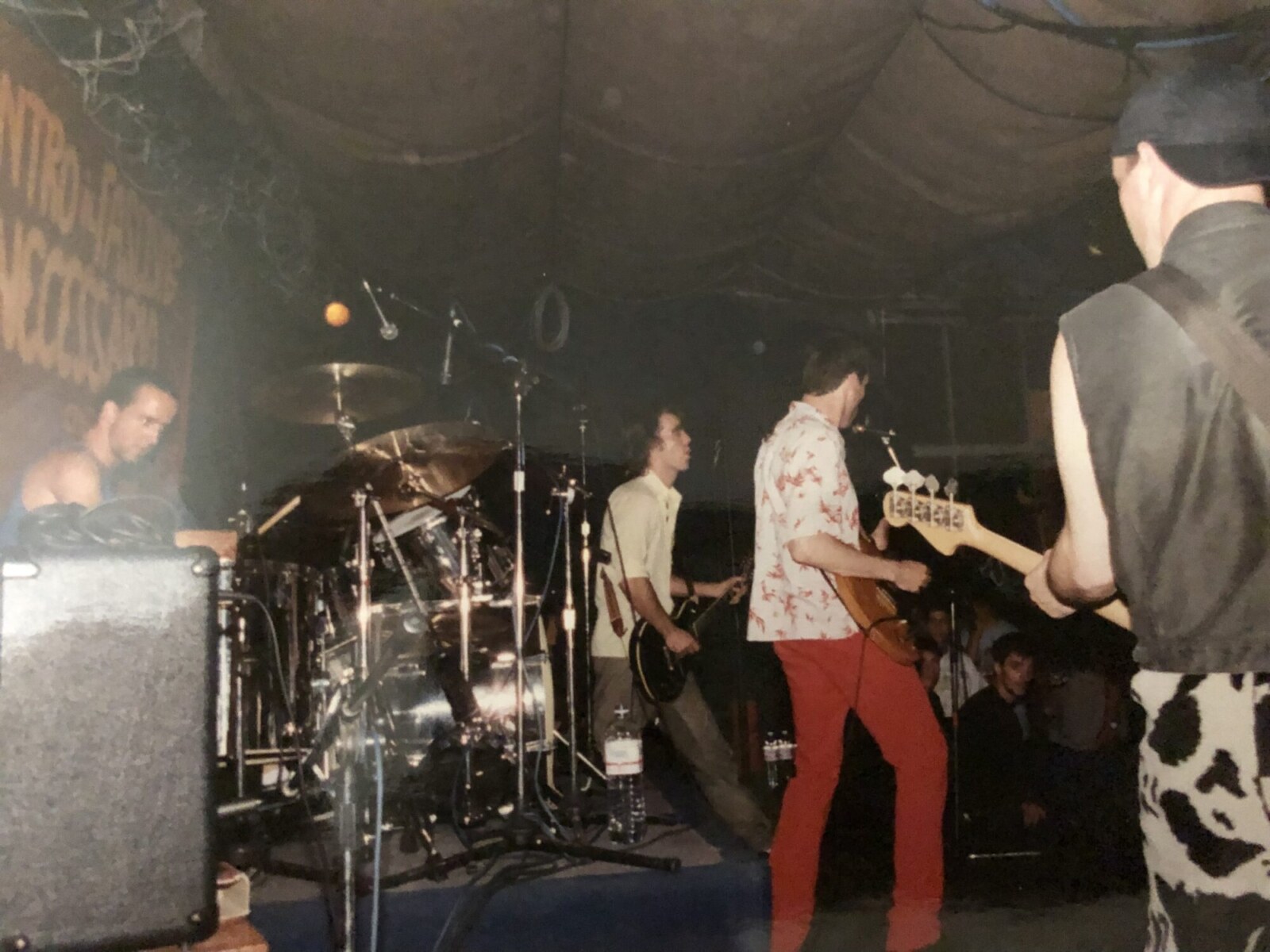
Towards the end of 1993 we had another release, the 5-track mini-CD ‘Bettie’. It contained a friendly indie-pop song about, or written for, the well known Dutch band Bettie Serveert (we were often referred to as “the other Bettie”, which became pretty annoying after a while), a sort of jazzy rockabilly tune, an extremely slow, atmospheric song with a contrasting Arena rock intermezzo, a Judy Garland cover and a Status Quo-like rocker sang in (lousy) German. From a “cool underground rock’n’roll” point of view we couldn’t have sank any lower.
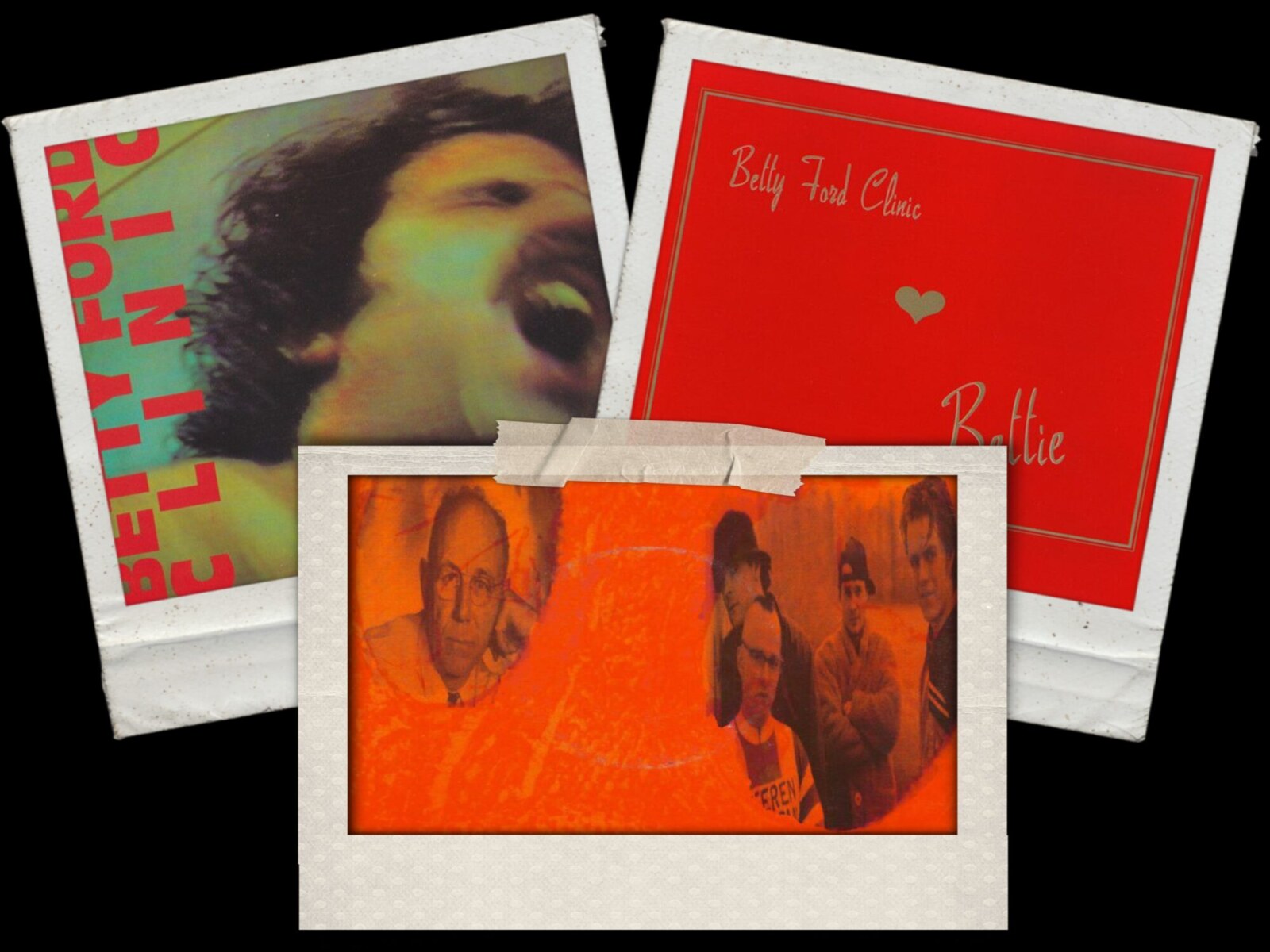
That was exactly what we were aiming for. We were very much aware of the “suffocating rules of subcultures”. We loved mocking group behaviour and people who tried to act as cool and tough as they possibly could.
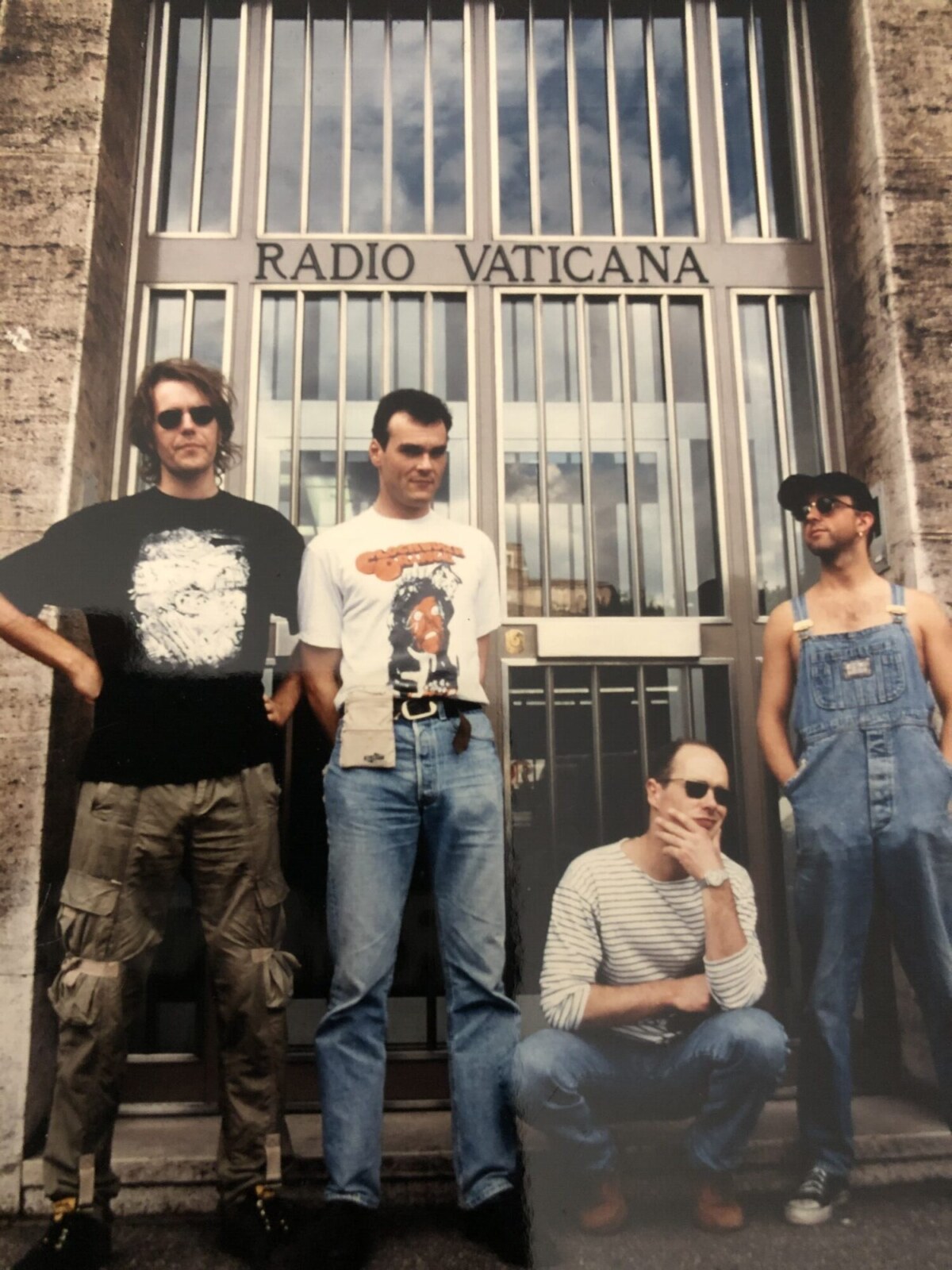
Nevertheless, “herd instinct” is an interesting phenomenon. Like the case with everything, there are two sides to the story. On one hand group behaviour totally sucks. It leads to hypocrisy and very little originality. On the other hand, without it there would be no civilization whatsoever. If it weren’t for group behaviour, rock’n’roll, flower power and punk rock would never have existed!
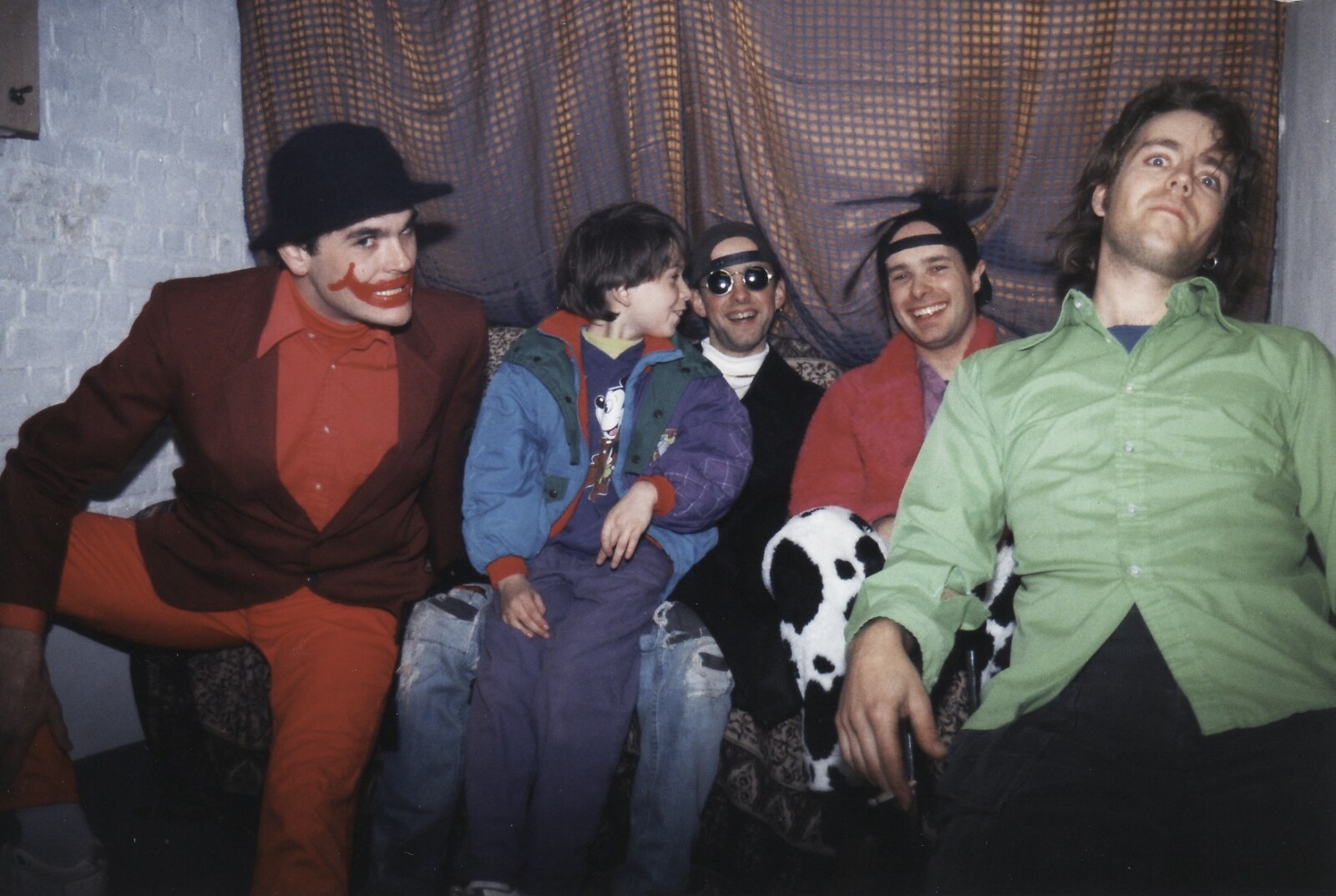
What led you to start a solo project, Ford’s Imaginary Inferno?
Betty Ford Clinic folded in 1995. By then I was living on a houseboat in Amsterdam and I didn’t feel like forming a new band straight away. However, I did want to continue writing and recording songs. So I bought a Tascam 4-track recorder and started my hometape project, Ford’s Imaginary Inferno. Some stuff I did completely solo, but I also invited friends (many ex-band mates) to contribute. Every now and then Ford’s Imaginary Inferno also performed live, with altering line-ups.
Would you mind taking some time and sharing a few sentences about each of Ford’s Imaginary Inferno releases, beginning with ‘Hot Balloon Drifts’?
The debut-CD ‘Hot Balloon Drifts’ was released by GAP in November 1995. The material was rather diverse, including ‘60s influenced pop, a few rock songs (with a drum machine), acoustic singer-songwriter stuff and experimental ditties. The release really benefited from the lo-fi thing that was going on back then. In order to promote the CD I formed a live band with Patrick, Belgian drummer Bootsie (a.k.a. Butsenzeller, also of Scoundrels), Michel van der Westen (from the band Mitch) on keyboards and Jeroen Ringers on bass. We played a string of shows in Holland and Belgium, and we also toured France.
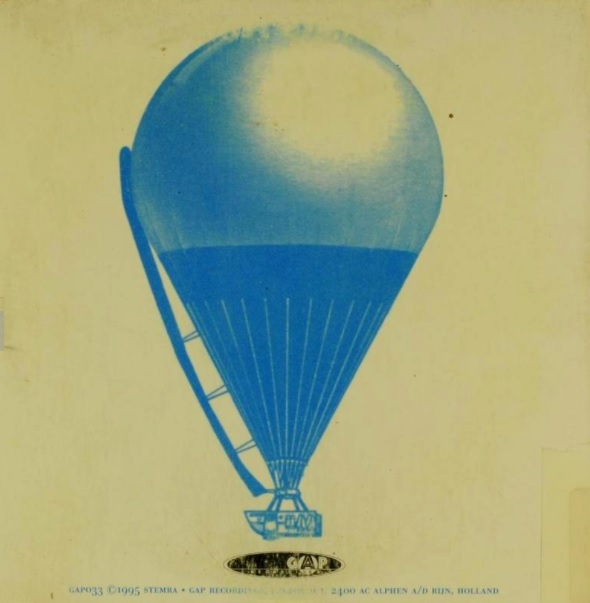
The second album ‘Life Without Ourselves’ (released by Clean Records in 1997) was recorded with the musicians from the first live line-up. The style was largely similar to the first CD, though slightly more psychedelic. I recorded the basic tracks on my houseboat and then we added the other instruments at Patrick’s studio. Combining lo-fi and hi-fi within the same recording was a bit of a gamble, but we sort of made it work.
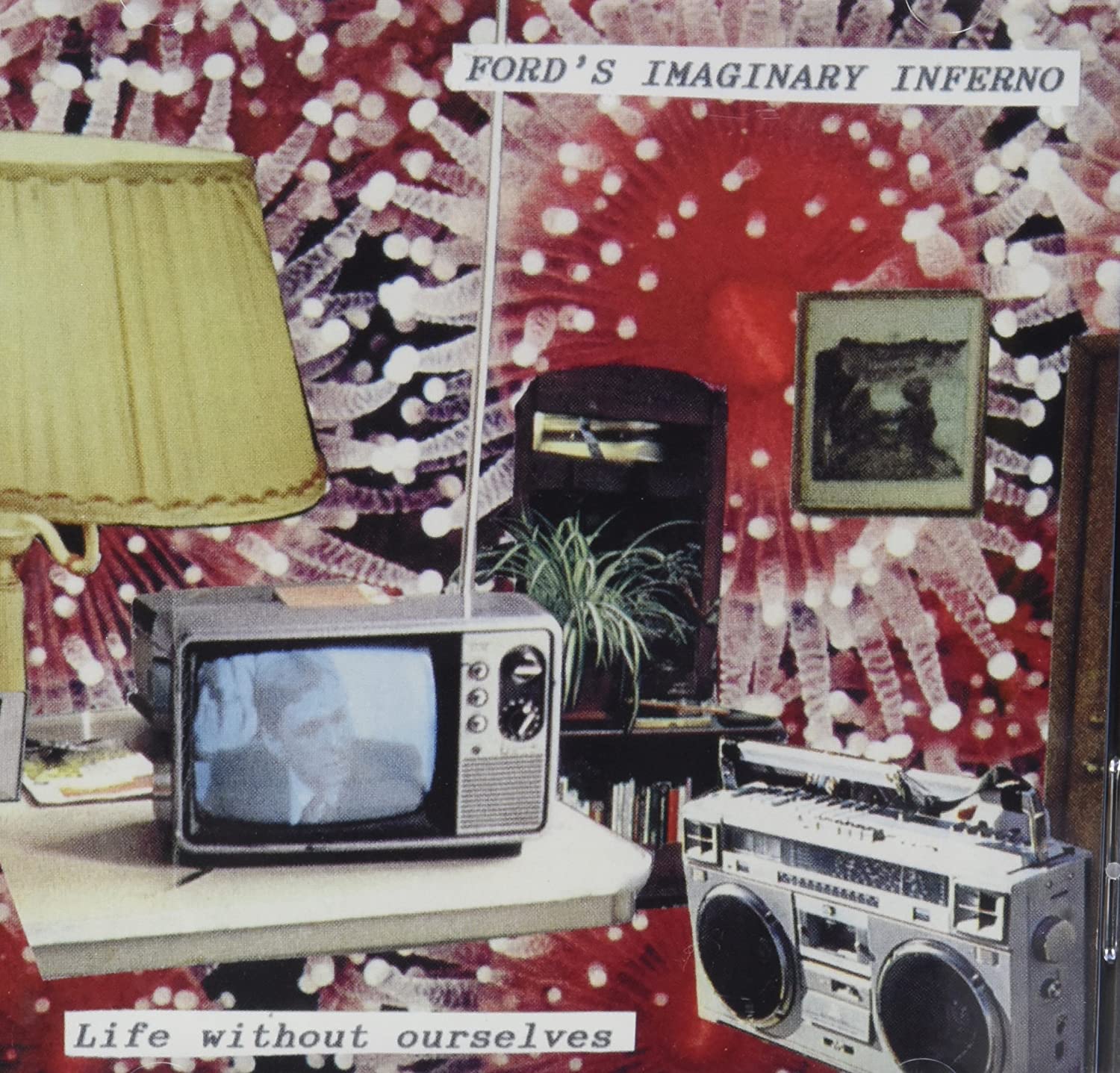
‘Love And Be Loved’ came out in 1999 through My First Sonny Weissmuller Records. The recordings included Pierre (Betty Ford Clinic) on drums. Response was great and we even flew to New York to play CMJ. (Keyboardist Michel had just left the live line-up to focus on his own band. He was replaced by Jeroen Ringers’ younger brother, Joris.)
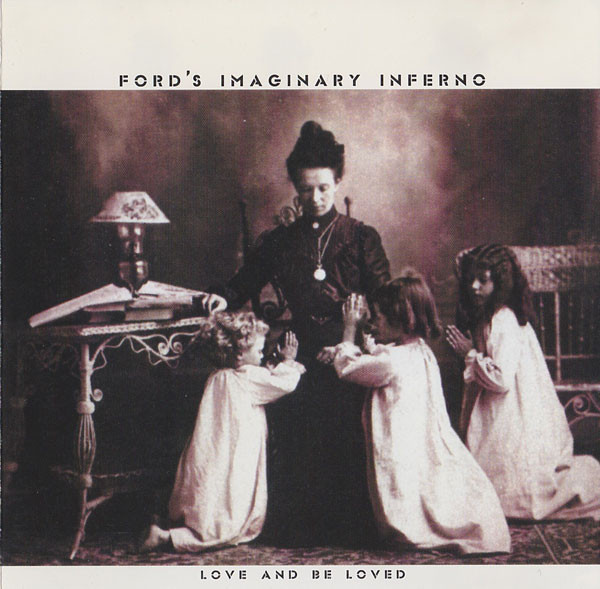
The fourth CD, ‘The Imaginary Recordings Part 4 Or How The Flower Factory Unexpectedly Exploded’, was issued in the year 2000. This one was very much ‘60s west-coast and popsike influenced. There are some enjoyable songs on the album, but the sound does suffer a bit from a lack of dynamics. I mixed the recordings at home, from cassette to cassette. I really should have gone to Patrick’s studio.
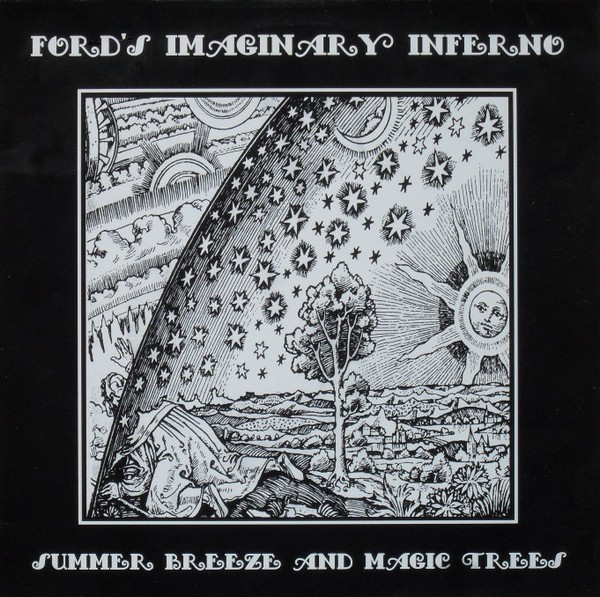
The vinyl LP ‘Summer Breeze And Magic Trees’ was recorded over a three-year period. Various drummers were involved, including Dan Seelig (ex-Phantom Surfers), who was living in Amsterdam at the time. The record was released in 2003 by the Excalibur Music Group, a label owned by my flamboyant record collector friend Frank Feyns. (He put out some interesting stuff, f.i. a 10” featuring demo recordings of the English ‘60s group Springfield Park and a reissue of the 1969 lp by Milkwood Tapestry, an extremely dualistic American duo that combined fuzz-rock with acid-folk.) ‘Summer Breeze And Magic Trees’ was a mellow, dreamy affair. My main influences at the time were ‘60s soft-psych, acid folk and German ‘Kosmische’ folk. (Regarding the latter, I thought I was 30 years too late. Now it turns out I was 20 years too early.) The first edition on yellow vinyl sold out fast and was followed by a second run on white vinyl.
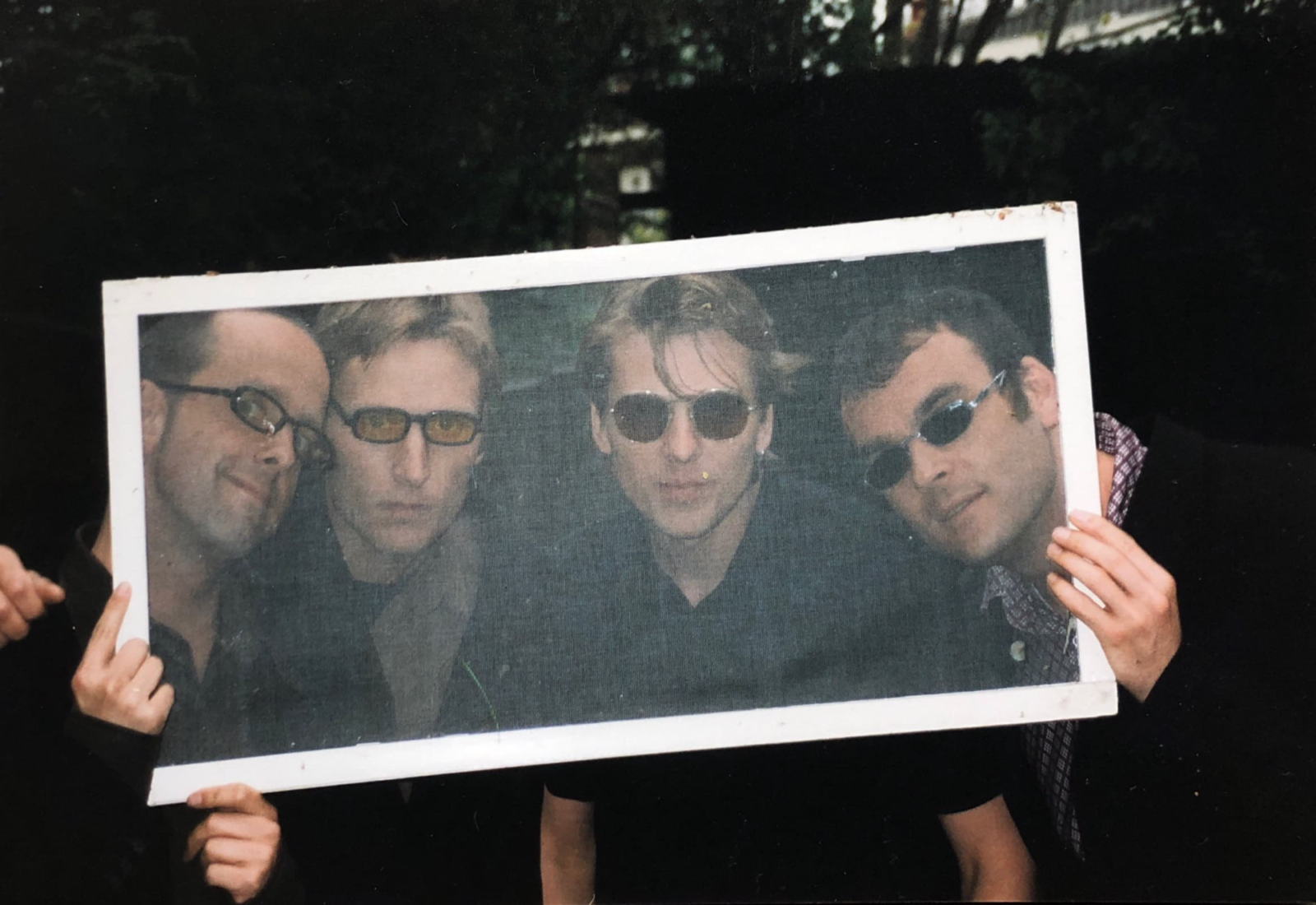
The final Ford’s Imaginary Inferno album, ‘Meet The Children Of Make-Believe’ (2004), was another LP-only release. (On blue vinyl.) It was in a similar trippy style as the previous album. On this record I played the drums myself, although I’m not a drummer at all. I thought it sounded fine, but at the same time I wasn’t too confident. So I credited the drums to a fictitious character named Domingo Hernandez. If critics would write anything nasty about the drumming, I could at least blame some non-existing Mexican guy. Fortunately I never heard anything negative about Domingo’s contributions. (No one ever said he was brilliant either.)
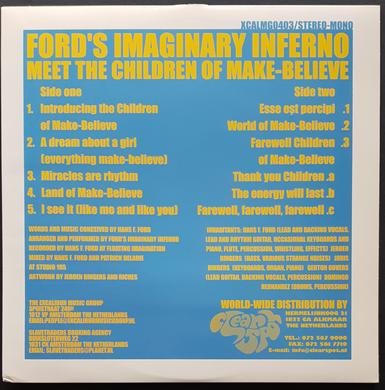
It was very exciting to see your return with the release of ‘Deniers Of Fuzz Will Be Executed’. Here you revisited your punk roots. Can you share some further words about it?
After finishing the sixth Ford’s Imaginary Inferno album I found out it’s much easier to stop making music than to quit smoking. I didn’t touch a guitar for 17 years. Nowadays I live a rather quiet life, together with my girlfriend Mariska (a.k.a. soccer Committee, who is no stranger to It’s Psychedelic Baby either). We live near the German border, surrounded by lots of nature. Until recently I had no plans to start making music again. I have my day job, I was writing for the Dutch record collectors magazine (I recently stopped) and I’m a bit of a birdwatcher. I didn’t have the feeling something was missing.
However, in January I was listening to the test pressing of the Waste ‘Lost Tapes’ EP and I became curious what I’d come up with if I would write some punk songs again. There was only one way to find out.

A week or so later I went to Patrick’s studio to record five short, no-nonsense punk tunes. Patrick handled the drums (he is a guitarist originally, but he’s also a super solid punk drummer!), he gave me a totally crushing guitar sound (two fuzz pedals at the same time!) and we recorded our first EP as Ford’s Fuzz Inferno. The result sounds like a mixture of garage-punk and early ‘80s hardcore. I’m very happy with it.
How was it to work with Patrick Delabie again after all these years?
I had a blast. When it comes to making music, Patrick and I know each other through and through. This makes working together really easy and lots of fun. There are no disagreements and no frustrating situations. The experience of visiting a studio for the first time after more than 17 years itself was quite special too. I felt like a total rookie (super excited!) and a seasoned veteran (everything under control) at the same time. It was an ideal combination.
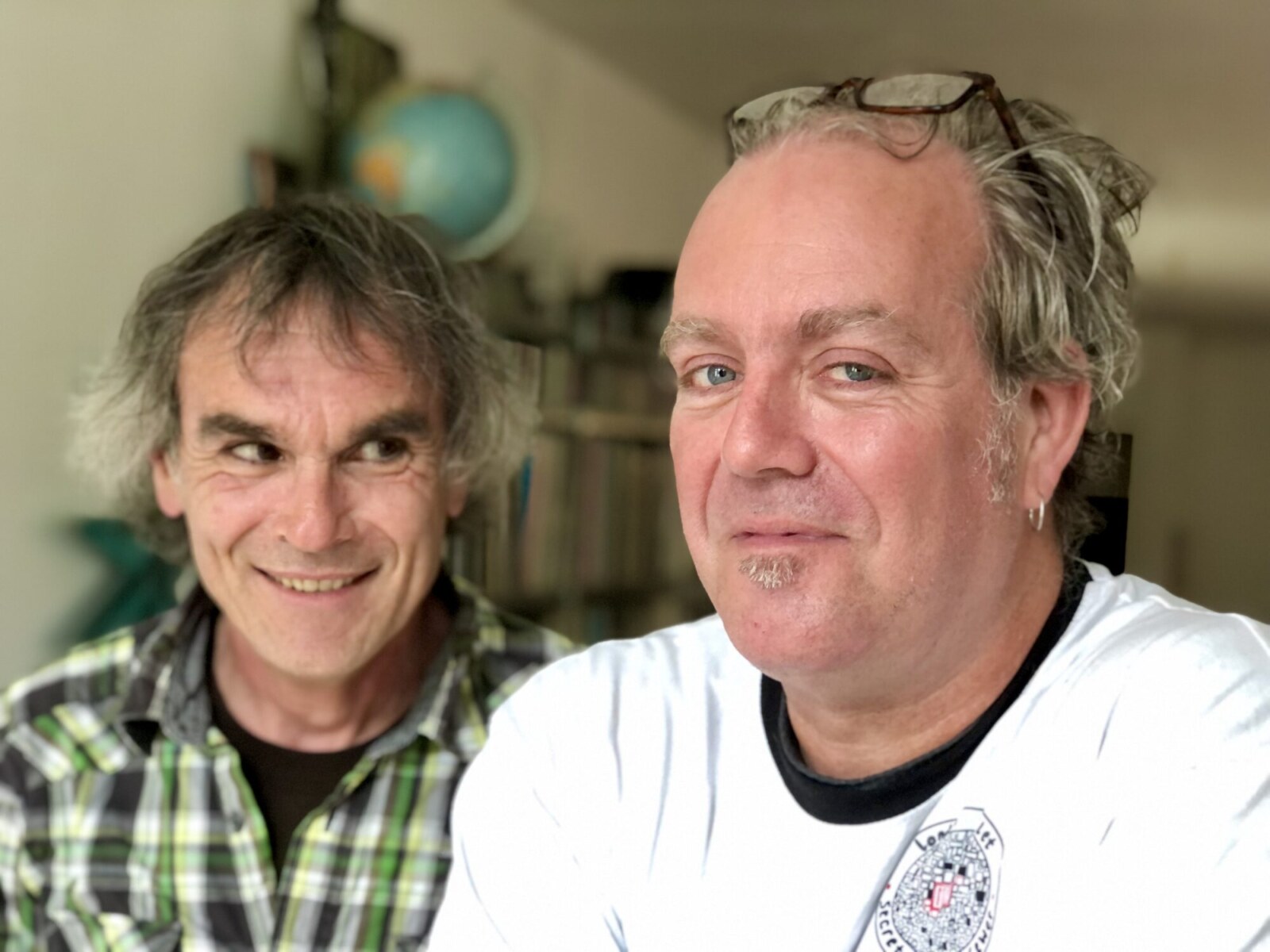
I really love the freak-noise jam!
Thanks! Cool to read you dig the (vinyl-only) bonus track. It wasn’t something we had planned. At the end of the EP-session, when we had finished the fifth track, we had some time left, but it wasn’t enough to record another “real” song. So we took the basic drum part and the guitar chords of the title track and started jamming away, with lots of wah wah and other effects. It’s radically different from the other songs, but we felt the result was interesting enough to use. And since there was some space left on the vinyl… I can easily imagine that fans of noise rock or psychedelic freak-outs like this track best.
Any sense of direction for your next venture? Do you have any new plans for recording some new material?
We actually already recorded the second Ford’s Fuzz Inferno EP last Summer. The title is ‘Flog Yourself With Fuzz’, it contains four songs and we’re going to put it on Bandcamp. The 7” vinyl release is due for January 2022. Compared to the ‘Deniers Of Fuzz…’ EP the material is more diverse, melodic and playful.
There are some fun vocal arrangements and we threw in a few guitar solos too. But not to worry, it’s all very hi-energy, the guitar sound is totally blistering and it’s 100% punk.

Looking back, were you influenced by bands from your country? Like for instance The Ex?
During my time with Waste there were a couple of Dutch bands that were influential. Regarding The Ex, I thought their approach to punk was special. I listened to their ‘Disturbing Domestic Peace’ 12” quite a few times. In the last song on the ‘Lost Tapes’ EP (‘Systeem’, with vocals by the girls) my guitar chops sound rather angular and stubborn. There might be something of an Ex-influence there. Other Dutch bands I listened to back then were Tröckener Kecks (with their original lead singer) and – of course – The Miranda’s. I’m pretty sure they were influential too. I think I was influenced by all the punk records I liked.
We have known each other for many years through Clear Spot. How did you originally join Clear Spot?
Between 1993 and 2000 the releases of Betty Ford Clinic and Ford’s Imaginary Inferno were distributed by Konkurrent in Amsterdam. They always were very supportive. When ‘Summer Breeze…’ was released I was contacted by Johan Visser of Clear Spot, who told me they wanted to distribute the LP. I found myself very unloyal (and ungrateful) towards Konkurrent, but since Clear Spot specialized in psychedelic music I decided to go for it. So that’s how I got to know the people at Clear Spot. I had been working as a booking agent since 1990. In 2005 I felt it was time for a change. I asked if I could take care of Clear Spot’s promotion and they thought it was a good idea. For a couple of years I was a part-time booking agent and part-time promo guy. I fully gave up booking shows a few years ago.
What are some of the most interesting records in your collection?
Haha, I suddenly have to think of that Poison Idea title, “Record Collectors Are Pretentious Assholes”. I mean, I don’t mind being an asshole… But well, okay, some interesting records… Why not start in Africa then?! A couple of years ago I took a serious dive into the late ‘60s and early ‘70s scenes of Nigeria and Zambia. I discovered lots of interesting, fuzzed-out stuff… BLO, Ofege, Colomach, Asiko Rock Group, The Peace, W.I.T.C.H. and Amanaz are only a few of those groups. I’m also fascinated by the early beat and psychedelic scenes of the countries east of the former Iron Curtain. There were some great bands in f.i. the GDR, Poland and Czechoslovakia. For fans of ‘60s beat and garage rock the Matadors album and the first two LP’s by Olympic are mandatory.
Is there an album that has profoundly affected you more than others?
There are quite a few. As far as punk goes, the early albums by The Stranglers, Damned, Adverts, Buzzcocks, Undertones and all those other UK punk bands as a whole left me no other choice than to dedicate my life to music. From the mid-‘80s on I got more and more interested in ‘60s pop and rock. First I bought albums by all the usual suspects, from The Kinks to The Small Faces, and from Hendrix to Jefferson Airplane. In 1986 or ‘87, after I stumbled upon ‘Forever Changes’ by Love, I became a serious ‘60s music freak.
Let’s end this interview with some of your favourite albums. Have you found something new lately you would like to recommend to our readers?
I have hundreds of favourite albums. I already mentioned some of them earlier on and here are a couple more, listed chronologically: ‘We Are Ever So Clean’ by Blossom Toes, ‘From Nowhere’ by The Troggs, the self-titled LP’s by Bonniwell Music Machine and Los Faros, ‘Permanently Stated’ by John Fred And His Playboy Band, ‘Hair’ by Zen, the first two LP’s by Os Mutantes, ‘Curtis’ by Curtis Mayfield, ‘First Utterance’ by Comus, ‘Virgin’ by Traffic Sound, ‘Wolf Creek Pass’ by C.W. McCall, ‘Black & White’ by The Stranglers, ‘Machine Gun Etiquette’ by The Damned, ‘Back From Samoa’ by The Angry Samoans, ‘New Day Rising’ by Hüsker Dü, ‘I Against I’ by Bad Brains, ‘God Ween Satan’ by Ween, ‘Heaven Born And Ever Bright’ by The Cardiacs…
If I have to recommend some new music, I can honestly say that the upcoming new album by Patrick’s ‘old’ punk band The Scoundrels sounds amazing. (It’s their first release since 1988!) It’s called ‘Oh No! Not Again!’ and the style moves around in the rather large space between, say, early UK Subs and Hüsker Dü, with some subtle nods to post-punk à la Gang Of Four. People who like those bands should check it out. The release is planned for early 2022.
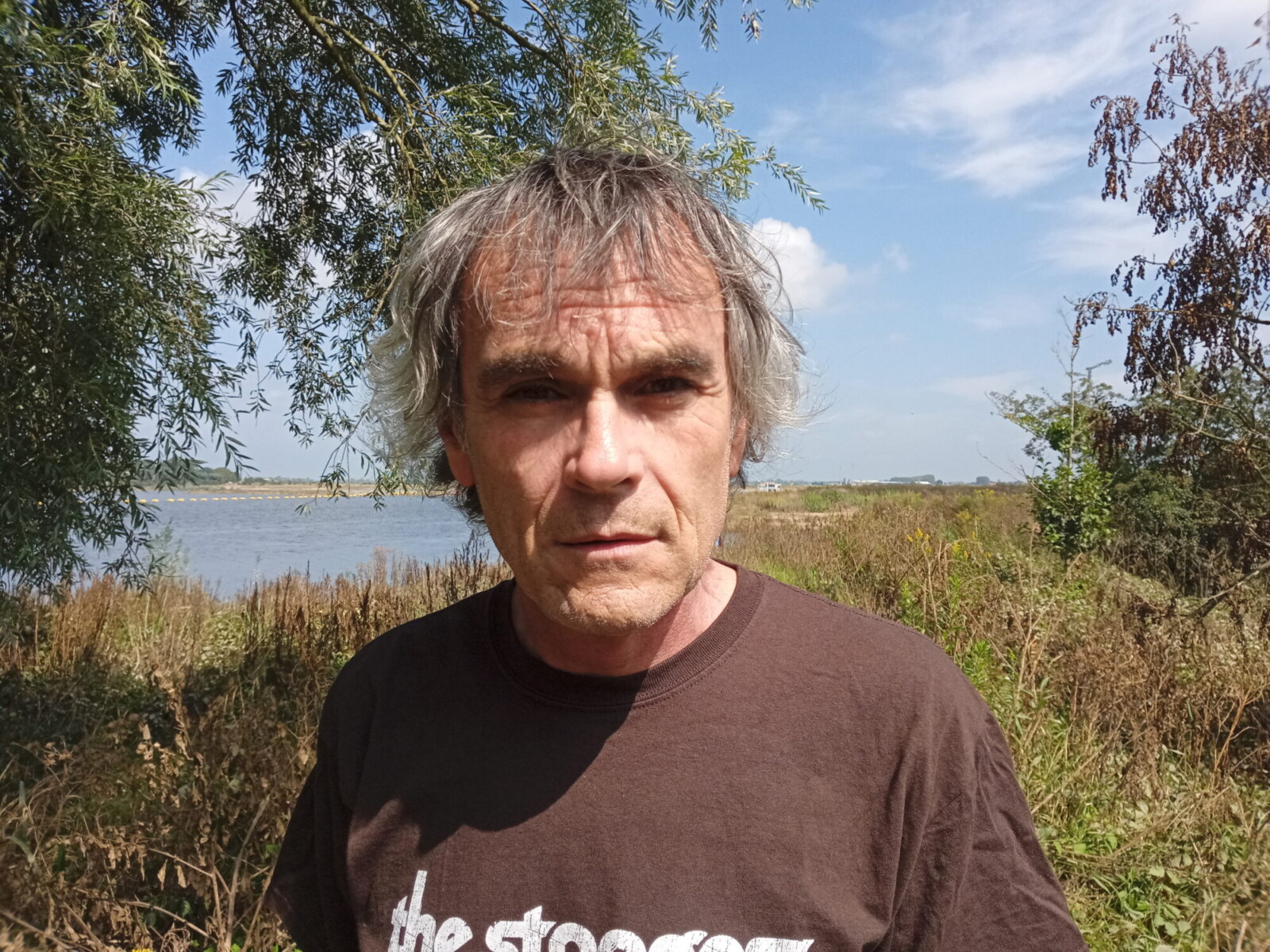
Thank you. Last word is yours.
Well, I said (or wrote) all there is to say (or write) about the bands I was in. It has become a very long story – sorry for that! – , but in the core it really all comes down to only one thing: THOU SHALT NEVER UNDERESTIMATE THE POWER OF FUZZ! Thank you and have a nice day.
Klemen Breznikar
Headline photo: Ford’s Imaginary Inferno in 1999
Waste Facebook

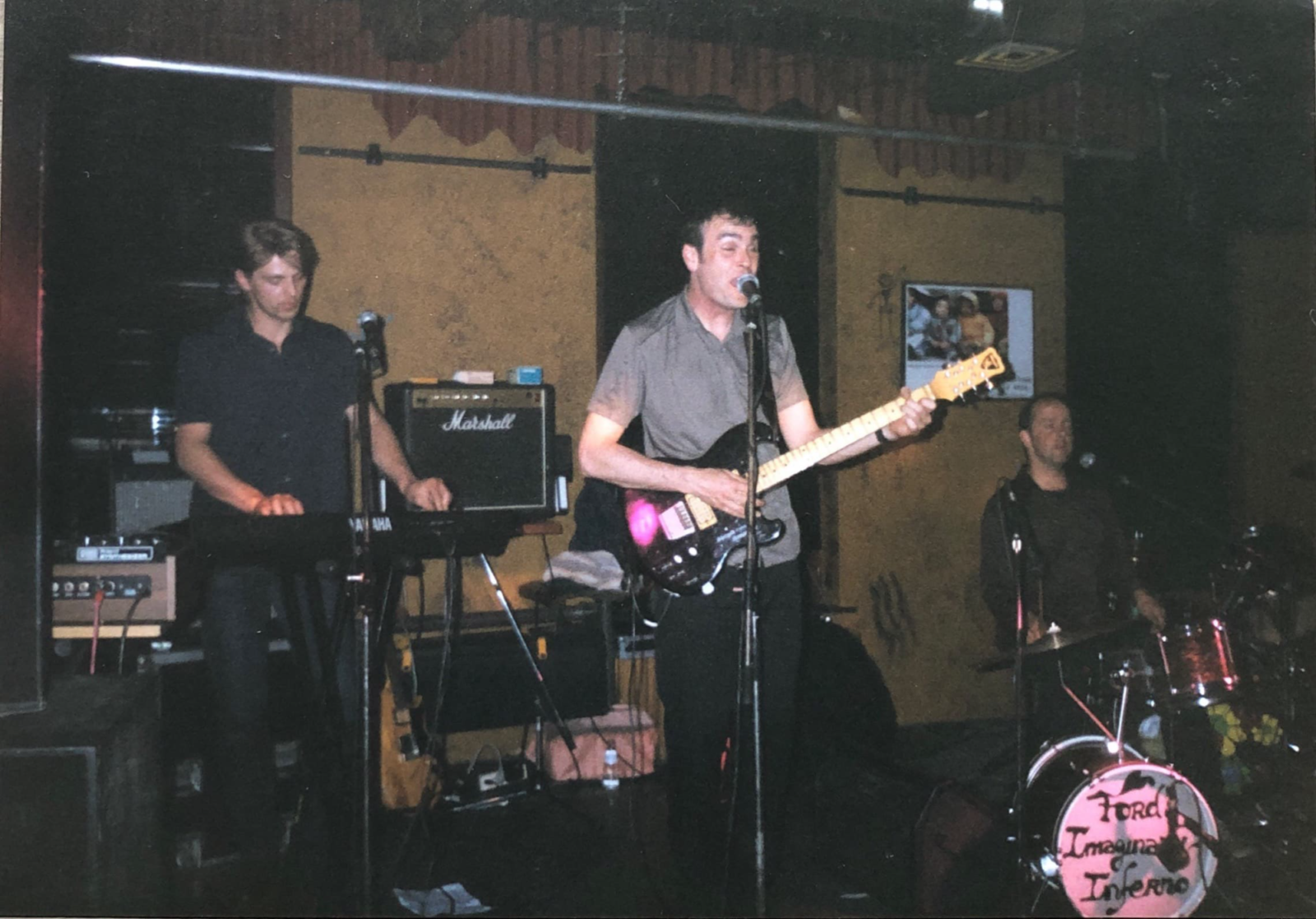



Thanks for the interesting interview Klemen !
A lot of hinks from bands that i didn’t know.
A lot of to do work research. GREAT !!